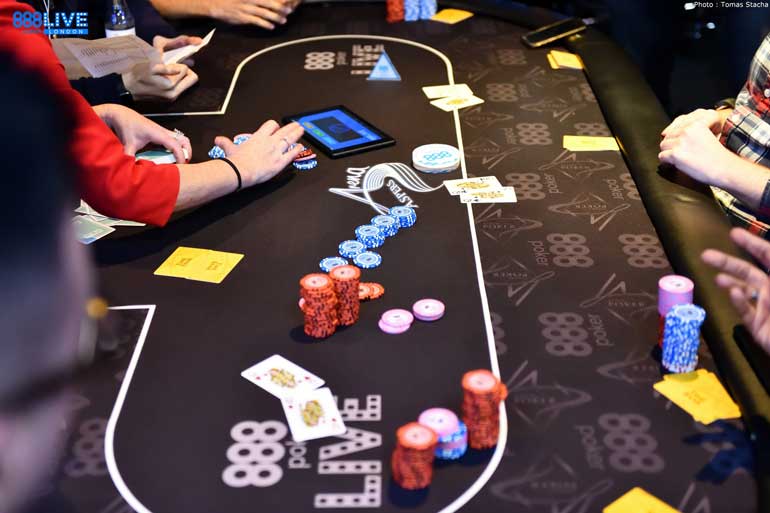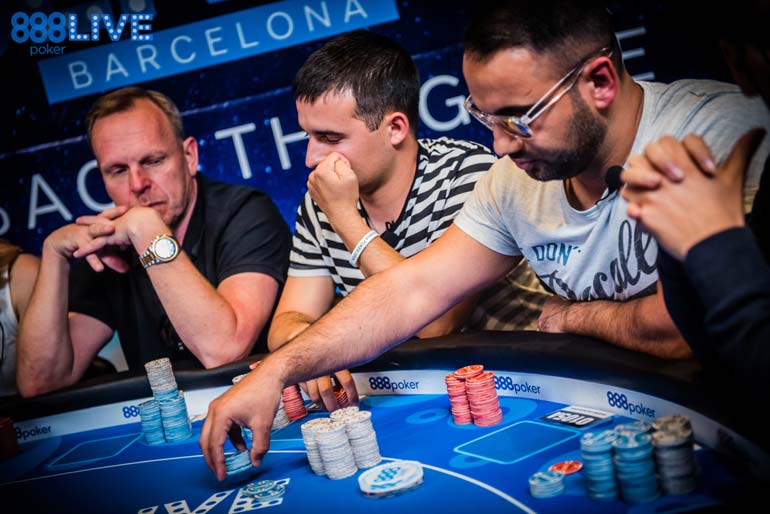Understanding when to call in poker is not always straightforward.
Even if we lose the pot, it doesn’t necessarily mean that our call was incorrect.
Similarly, even if we win, we still need to carefully consider whether our call will be profitable over the long run.
Is there a way of knowing more accurately whether our calls are correct or not?
Absolutely. In this short strategy guide, we’ll discuss how we can use pot odds to begin instantly improving our results at the poker tables.
Learning Poker Odds
What are Pot Odds Anyway?
Pot odds in poker describes the amount we need to call compared to the amount that is currently in the pot.
This knowledge is crucial. We don’t need to win very often to make a profit if there is already many chips in the pot.
It might seem logical to believe that we need to win more than 50% of the time for calling to be correct. But this assumption is not true.
It’s often correct to call even if we expect to lose most of the time. Over time, we stand to win more than the amount we are risking.
How Are Pot Odds Calculated?

We can work out our pot odds by calculating the percentage of the total pot we are investing on our call.
For example, imagine the following scenario -
There is $100 in the pot, and our opponent bets $50. What percentage of the total pot would we be investing if we make the call?
After our call, there would be $200 in the pot, and we would have invested $50 of that $200. So, we are investing 25% (one quarter) of the total pot.
We can say that we are being offered 25% pot odds on the call.
How Are Pot Odds Used?
The pot odds percentage is more than just a percentage. It tells us directly how often we need to win the pot for calling to be profitable.
In the above example, we are offered 25% pot odds. If we expect to win the pot more than 25% of the time after calling, calling will be profitable.
This scenario is true, even if we were to win the pot 30% of the time. We would still lose 70% of the time after calling!
If we only expected to win the pot 20% of the time, calling would be a losing play in the long run. (Even though we would still go on to win the pot 20% of the time.)
|
Did You Know? The idea that calling can be profitable even in situations where we lose most of the time can be confusing at first. How exactly does it work? Imagine a mysterious stranger offers us a bet. He wants to wager $1,000,000 in exchange for a $1 wager from us - winner takes all. The catch? The stranger gets to win everything 75% of the time, while we win everything only 25% of the time. Even though we’ll lose most of the time, this is an extremely profitable bet because we stand to win a lot but lose relatively little. |
How Do We Know How Often We’ll Win?
It’s all very well knowing how often we need to win, but how do we know how often we will, in reality, win?
This situation is where pot equity comes into play. It’s another percentage that tells how often we can expect to win based on our opponents’ hands.
Pot equity is not especially straightforward to work out. We don’t usually know exactly which hands our opponent is betting.
It’s poker, after all!
As we improve at poker, we’ll get better at estimating how often we are likely to win in various situations.

Example 1: Facing a River Bet
There is $100 in the pot on the river, and our opponent bets $100. We have a weak pair, and we think our opponent is bluffing around 40% of the time. Should we call?
In this example, we would be investing 33.33% (one third) of the total pot if we were to call. So, we need to win more than 33.33% of the time for calling to be profitable.
We have a weak pair, so it’s likely we’ll only win if our opponent is bluffing. Based on past play, we guess they are bluffing around 40% of the time. So, calling will be profitable in this case.
Rather than calculating our pot odds every time, memorising some standard pot odds values makes sense. See the table under Common Pot Odds Values below.
Example 2: Facing a Flop All-In
There is $50 in the pot on the flop and our opponent bets all-in for their last $100. We have the nut flush draw. Should we call?
It’s a great idea to memorise how often different types of draws hit by the river. See the table Common Draws and Equity below.
A flush draw will hit around 35% of the time by the river. So, we likely have about 35% pot equity, assuming we will only win if we make our flush.
So how often do we need to hit for calling to be profitable? Since our opponent is betting twice the pot, we would be investing 40% of the total pot on our call.
We would need to win more than 40% of the time for calling to be profitable. We will only hit our flush 35% of the time. Folding is correct.
Common Pot Odds Values
The best way to approach pot odds is by memorising the values for a few standard bet sizings.
The more traditional approach is to try and calculate pot odds mid-hand. The problem here is that this takes away our focus from other essential details in the hand.
It’s much more efficient to ‘just know’ our pot odds in any given situation.
| Facing Bet Size (%) | Pot Equity Required to Call |
| 20 | 14.29 |
| 33 | 19.88 |
| 50 | 25.00 |
| 66 | 28.45 |
| 80 | 30.77 |
| 100 | 33.33 |
| 150 | 37.50 |
| 200 | 40.00 |
Common Draws and Equity
The traditional way of working out how often our draw will hit involves stopping mid-hand to count our outs. An out is any card that can improve us to the best hand.
We should avoid running unnecessary calculations mid-hand, allowing us to focus entirely on the action.
It’s far easier to memorise how often common types of draws will hit by the river.
The following table lists the most common draws and their percentage chance of hitting.
| Outs | Turn to River | Flop to River |
| Flush Draw + Open Ended Straight Draw | 32.60% | 54.10% |
| Flush Draw + Gutshot | 26.10% | 45.00% |
| Flush Draw | 19.60% | 35.00% |
| Open Ended Straight Draw | 17.40% | 31.50% |
| 2 Overcards (to make top pair) | 13.00% | 24.10% |
| Pair (to make two pair or trips) | 10.90% | 20.30% |
| Gutshot | 8.70% | 16.50% |
In Which Situations Can Pot Odds Be Used?
Pot odds should only be used in the following two situations -
- We face an all-in bet from our opponent (or very close to it).
- We are making the final decision in a hand before showdown.
We should not be involved in any further betting action for pot odds to be correct after making our call.
We should use an implied odds calculation if there are still additional chips to play for after making our call. This particular type of pot odds calculation factors in chips that we might win or lose later on in the hand.
In our table, Common Draws and Equity, we did not consider the chance of our draw hitting from flop to turn. We would only need such a number if we used an implied odds calculation.
A pot odds calculation assumes that we are already all-in on the flop. So, we would only need to account for how often we hit going from flop to river.
Putting it Together
It takes time to master pot odds. But it doesn’t need to involve complicated calculations if we start by memorising the basic values.
Why not start with the common values in the tables above? Try to match them up to the correct situations in your next poker session.
Although pot odds is a relatively straightforward concept, the improvement to our winnings can potentially be massive!


